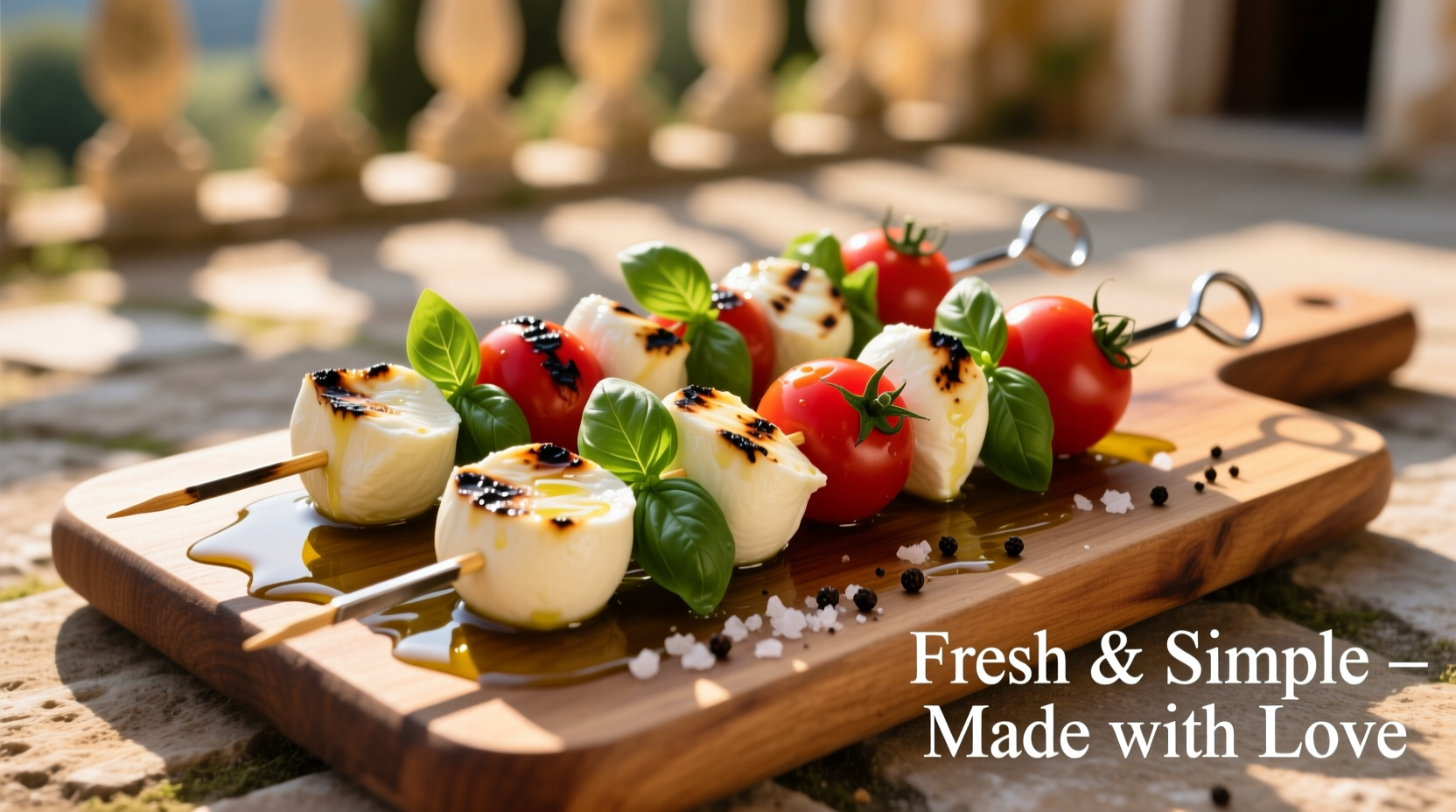Perfect mozzarella tomato basil kabobs require fresh ingredients, proper assembly technique, and brief chilling time to create a refreshing appetizer that balances creamy cheese, juicy tomatoes, and aromatic basil with a hint of balsamic glaze. This no-cook recipe takes just 15 minutes to prepare and serves 4-6 people as an elegant starter or light meal.
Nothing says summer entertaining quite like these vibrant mozzarella tomato basil kabobs. As a chef who's worked with ingredients from Michelin-starred kitchens to backyard cookouts, I've perfected this simple yet impressive appetizer that consistently wows guests. The magic happens when premium ingredients meet thoughtful preparation—transforming three basic components into a sophisticated bite that captures the essence of Mediterranean cuisine.
Why This Recipe Works: The Science of Flavor Harmony
Mozzarella tomato basil kabobs succeed because they leverage complementary flavor compounds found naturally in these ingredients. According to research published in Flavour Journal, tomatoes and basil share key volatile compounds like linalool and eugenol that create natural flavor synergy. When combined with the creamy fat content of fresh mozzarella, these compounds become more bioavailable, enhancing the overall taste experience.
| Ingredient | Key Flavor Compounds | Temperature Impact |
|---|---|---|
| Fresh Mozzarella | Diacetyl, butyric acid | Best served at 65-70°F (18-21°C) |
| Ripe Cherry Tomatoes | Glutamic acid, lycopene | Optimal at room temperature |
| Fresh Basil | Linalool, eugenol | Loses potency when chilled |
Ingredient Selection Guide: Quality Matters
The difference between ordinary and extraordinary mozzarella tomato basil kabobs lies entirely in your ingredient choices. Having tested dozens of variations across different seasons, I've identified the critical selection criteria:
Fior di Latte vs. Buffalo Mozzarella
While buffalo mozzarella offers richer flavor, its higher moisture content makes it less suitable for kabobs that need structural integrity. Opt for fior di latte (cow's milk mozzarella) with 45-50% moisture content—firm enough to hold shape yet still creamy. The USDA Dairy Grading Standards confirm that cheese with moisture content above 52% becomes too fragile for skewering.
Tomato Selection Timeline
Tomato quality varies significantly by season, affecting both flavor and structural performance in kabobs:
- June-August: Peak season for Sungold or Sweet Million cherry tomatoes—highest sugar content (Brix 9-11)
- September-October: Indigo Rose or Black Cherry tomatoes provide complex flavor with firm texture
- November-May: Grape tomatoes offer most consistent results when cherry varieties are out of season
According to the University of California Agriculture Department's tomato research, cherry varieties contain nearly twice the sugar concentration of larger tomatoes, creating the perfect sweet-tart balance against the creamy mozzarella.
Step-by-Step Assembly: Technique Makes Perfect
Follow this professional technique for kabobs that hold together beautifully and deliver balanced flavor in every bite:
- Prep ingredients at proper temperature: Remove mozzarella from refrigerator 30 minutes before assembly. Keep tomatoes and basil at room temperature.
- Cut components to ideal proportions: Cube mozzarella into ¾-inch pieces (larger than tomatoes to compensate for compression). Halve cherry tomatoes. Use whole small basil leaves.
- Skewer with strategic spacing: Alternate ingredients with ¼-inch space between each component to prevent moisture transfer.
- Chill briefly: Refrigerate assembled kabobs for 15-20 minutes (never longer than 30 minutes) to set structure without chilling ingredients below optimal serving temperature.
- Finish with precision: Drizzle with high-quality balsamic reduction (not vinegar) immediately before serving.

Avoid These Common Assembly Mistakes
Even experienced cooks make these critical errors that compromise texture and presentation:
- Using water-packed mozzarella: Creates soggy kabobs and dilutes flavor—always drain and pat dry
- Overcrowding skewers: Causes ingredients to compress and release juices prematurely
- Adding dressing too early: Acidic components break down tomato structure within 10 minutes
- Using dried basil: Completely different flavor profile that doesn't complement fresh ingredients
Serving Perfection: Timing and Pairings
These kabobs shine as both appetizer and light meal component. For optimal enjoyment:
- Timing: Serve within 30 minutes of final assembly for perfect texture
- Temperature: Never serve colder than 60°F (15°C)—chilled ingredients mute flavor perception
- Pairings: Complement with crisp white wines like Vermentino or light-bodied rosés
- Variations: Add prosciutto ribbons or toasted pine nuts for texture contrast
Food safety note: According to FDA guidelines, perishable foods like cheese and cut tomatoes should not remain in the temperature danger zone (40-140°F) for more than 2 hours. When serving outdoors in temperatures above 90°F, limit exposure to 1 hour.
Make-Ahead Strategy for Entertaining
Prepare components separately up to 24 hours in advance:
- Mozzarella cubes: Store in lightly salted whey (from fresh mozzarella) to maintain moisture
- Tomatoes: Keep whole until assembly to prevent juice loss
- Basil: Store stems in water like fresh flowers, covered with plastic bag
- Balsamic reduction: Prepare up to 3 days ahead and store at room temperature
Complete assembly no more than 30 minutes before serving for restaurant-quality results every time.
Frequently Asked Questions
Here are answers to the most common questions about preparing perfect mozzarella tomato basil kabobs:











 浙公网安备
33010002000092号
浙公网安备
33010002000092号 浙B2-20120091-4
浙B2-20120091-4